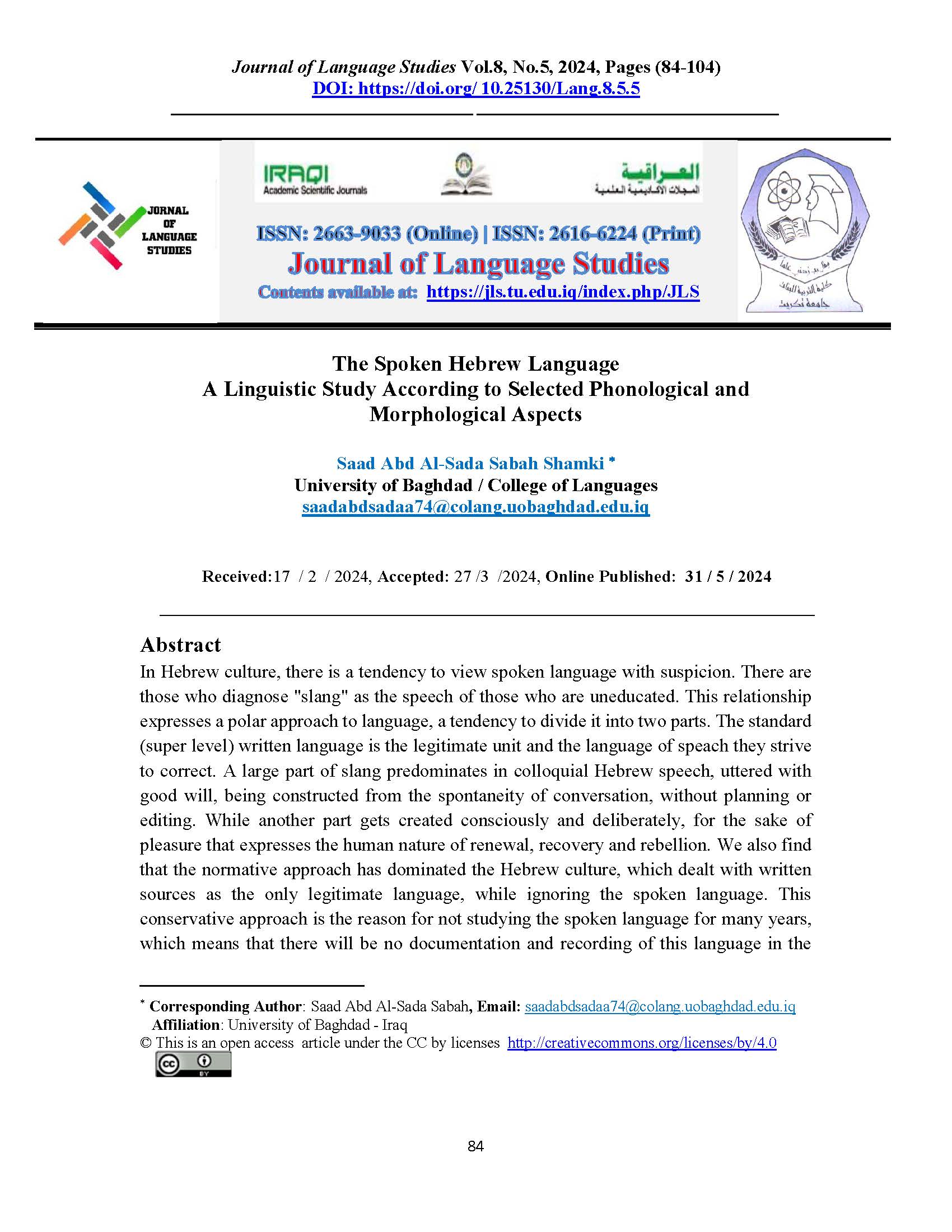The Spoken Hebrew Language A Linguistic Study According to Selected Phonological and Morphological Aspects
DOI:
https://doi.org/10.25130/Lang.8.5.5Keywords:
spoken Hebrew, Hebrew phonology, Hebrew morphologyAbstract
In Hebrew culture, there is a tendency to view spoken language with suspicion. There are those who diagnose "slang" as the speech of those who are uneducated. This relationship expresses a polar approach to language, a tendency to divide it into two parts. The standard (super level) written language is the legitimate unit and the language of speach they strive to correct. A large part of slang predominates in colloquial Hebrew speech, uttered with good will, being constructed from the spontaneity of conversation, without planning or editing. While another part gets created consciously and deliberately, for the sake of pleasure that expresses the human nature of renewal, recovery and rebellion. We also find that the normative approach has dominated the Hebrew culture, which dealt with written sources as the only legitimate language, while ignoring the spoken language. This conservative approach is the reason for not studying the spoken language for many years, which means that there will be no documentation and recording of this language in the early years of the establishment of the Zionist entity in Palestine. The development of language is considered one of the greatest achievements of the Zionist movement. In the early years of the Hebrew language revival, the Hebrew language revivers did not differentiate between written and spoken language, and believed that deviations in speech would be corrected when they were able to master the language just as misspellings. Today, the spoken language has priority in Hebrew linguistic research, because of its historical precedence, and there is a clear distinction between languages that stems from the different nature of each medium.
References
- אסתר בורוכובסקי בר-אבא (2008) , מבעים מקוצרים בעברית המדוברת , לשוננו: כתב-עת לחקר הלשון העברית והתחומים הסמוכים לה, כרך ע , התשס"ח .
- אשר לאופר (2004) , תעתיק פונטי של עברית מדוברת , לשוננו: כתב-עת לחקר הלשון העברית והתחומים הסמוכים לה, כרך סו , מס' ג/ד , התשס"ד .
- ברוך אברהם לוין (1978) , פרקים בתולדות העברית המדוברת , כתב העת ארץ-ישראל: מחקרים בידיעת הארץ ועתיקותיה , כרך יד, ספר ח"א גינזברג תשל"ח .
- ניסן נצר (1997) , כס"ח - שורש רב-שימושים בעברית המדוברת , לשוננו: כתב-עת לחקר הלשון העברית והתחומים הסמוכים לה , כרך ס , מס' א/ב ,אדר התשנ"ז .
- נמרוד שתיל (2005) , פה" ו"כאן" בעברית הדבורה , לשוננו: כתב-עת לחקר הלשון העברית והתחומים הסמוכים לה, כרך סז, מס' ב , אדר ב' התשס"ה .
- עינת גונן ויעל רשף (2017) , תנועת התחילית בבניין הפעיל בעברית המדוברת לאור עדויות מהקלטות מוקדמות , לשוננו: כתב-עת לחקר הלשון העברית והתחומים הסמוכים לה, כרך 79 , מס' 4 , אלול התשע"ז .
- Esther Borochovsky Bar-Aba (2005) , Towards a description of spoken hebrew , Hebrew studies, Vol. 46 .
- Yael Reshef (2005) , Ddirect speech in non-literary texts: a possible source of information on the early charecter of spoken hebrew , hebrew studies, Vol. 46 .

Downloads
Published
Versions
- 2024-05-31 (2)
- 2024-05-31 (1)
